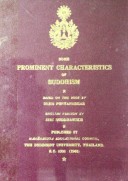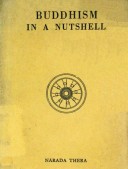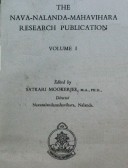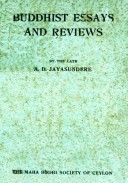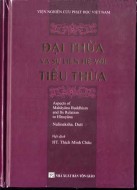Tìm Sách
Sách tiếng Anh-English >> Prominent Characteristics of Buddhism
Thông tin tra cứu
- Tên sách : Prominent Characteristics of Buddhism
- Tác giả : Sujib Punyanubhab
- Dịch giả : Siri Buddbasukh,
- Ngôn ngữ : Anh
- Số trang : 496
- Nhà xuất bản : Mahamakuta Educational Council
- Năm xuất bản :
- Phân loại : Sách tiếng Anh-English
- MCB : 1210000004867
- OPAC :
- Tóm tắt :
FOREWORD
The volume now presented was written in Thai by Mr. Sujib Punyanubhab, an expert in the Tripitaka and lecturer in the Mahãmakuta Educational Council, The Buddhist University. Due to its being based on an extensive research, it is very popular in the Buddhist circles in Thailand. Now the author, together with Mr. Siri Buddbasukh, a lecturer of English, has joined efforts in their attempts to render it into English with the purpose of making it known also by the English-reading public.
Through the essays therein the readers will be acquainted with various prominent characteristics which show unquestionably, among others, the intelligent aspect of Buddhism. The most prominent is perhaps the Buddha’s urge for the people to use their intelligent or reasoning impartially before accepting or rejecting any part of the Teaching This 18 regarded as a right approach to Buddhism. It is also worth noting that there is here no threat or luring promise of any kind or degree.
The combined efforts of the two lecturers are highly appreciated. For the following instructive essays are sure to offer new approaches to the Buddha’s Dhamma for many people, thereby giving them a true and accurate picture of Buddhism.
PHRA DEBKAVĨ
Secretary-General,
TABLE OF CONTENTS
INTRODUCTION. 1-21
B. E. 2500, — 2,545 years of Buddhism……………….1
Asoka’s Missionary Movement……………….1
Dominating Influence of Buddhism in Thailand……………….2
The Study of Buddhism……………….2
Buddhism versus Present Civilization……………….3
Compassion and Tolerance……………….3
Purpose of the Present Work……………….4
What is Buddhism? ……………….4
Who and What is the Buddha ? ……………….5
The Historic Buddha……………….5
The Generic or Legendary Buddha……………….6
Potential Power of Man……………….7
Three Kinds of Buddha……………….3
- The SAMMASAM BUDDHA……………….8
- The PACCEKABUDDHA……………….8
- The SUTABUDDHA or ANUBUDDHA……………….8
Classification of Religions……………….9
- THEISM……………….9
Buddhist Attitude towards Theism……………….9
What Looks Like Prayer……………….10
Trend of Practice Required in Buddhism……………….11
- ATHEISM……………….12
Is Buddhism Theism or Atheism ?……………….13
Epitome of the Buddhist Practice……………….13
Manners of the Buddha’s Teaching……………….14
- Revolution……………….14
- Reformation or Re-interpretation……………….15
- Reconstruction……………….16
Summary of Twelve Essays on Some Prominent Characteristics of Buddhism……17
Essay No. 1 MIRACLE. 23 34
A Buddhist’s Faith should not be Based on Miracles……………….27
Buddhist Attitude towards so-called Miracles……………….27
A Life of Courage, Faith and Sacrifice……………….28
Freedom of Reasoning, Doubt and Investigation……………….28
Buddhist Sense of the Word ’Miracle’ ……………….29
Miraculous Powers Not to be Treated as Final Attainment……………….30
Facts and Fictions about Supernormal Powers……………….31
Increasing Evidence of Possibility……………….32
Attainment of Psychio Powers to be Only By-product……………….33
Essay No. 2 DEMOCRACY. 35-57
Origin of Democracy in Greece……………….39
Three Consecutive Periods in the History of Greece……………….40
How Buddhism is a Democracy……………….40
Comparison between Grecian Democracy and Buddhism……………….40
SOLON: Forfeiture of Personal Freedom Prohibited……………….41
Democracy in Buddhism during the time of Solon……………….43
CLEISTHENES: The Right to Vote and Banishment by Plebiscite……………….43
PERICLES: The Golden Age……………….44
Evidence of Democratic Spirit in Buddhism……………….45
Three Kinds of Ordination……………….45
Quorum……………….46
Quorum for Each Activity of the Sangha……………….47
SIMA or Consecrated Boundary……………….49
Freedom of Voting……………….51
Texts of Formal Announcement to the Sangha……………….52
Announcement for the KATHINA Procedure……………….52
Announcement for the Ordination Procedure……………….53
Argument Based on Chronological Records……………….55
Dates Compared……………….56
Essay No. 3 SLAVERY 59-85
Slavery a Worldwide Institution……………….55
Causes of Slavery……………….55
Two More Causes of Slavery……………….56
Slavery In Ancient Times……………….57
Condition of Slaves in Greece and Rome……………….57
Slavery In England……………….68
Religious Attitude towards Slavery……………….69
Influential Role of Monks……………….70
The League of Nations and Slavery……………….70
Existence in the Modern World of Slavery……………….71
King Rama the Fifth and Slavery In Thailand……………….72
Kinds of Slaves……………….72
Movement towards Slavery-Abolition Act……………….73
Other Reforms……………….75
- Abolition of Wrist-tattooing……………….76
- Abolition of Corvée Labour……………….76
- Expropriation……………….76
- Equalization of Individual Dignity……………….76
- Practice of Criminal Court……………….77
- Lashing of Prisoners……………….77
Buddhism and Slavery……………….78
Buddhist Attitude towards Slavery……………….78
From the Book of Discipline……………….78
From the Book of Discourses……………….79
Metaphorical Sense of the Word ‘Fire’……………….80
Buddhist Conception of Spiritual Slavery……………….81
Spiritual Slavery Not to be Overlooked……………….81
The Untamed Stallion of Mind……………….82
First Duty of a Buddhist……………….83
Buddhist Method of Releasing Mail from Spiritual Enslavement……………….84
Crude Enslavement……………….84
Mild Enslavement……………….84
Subtle Enslavement……………….85
Essay No.4 FORUM OF MORALITY. 84-113
First Example: Story of an Exceptional Outcaste……………….91
Second Example: SUNDANIKASUTTA……………….96
Third Example: AMBATTHASUTTA……………….97
Fourth Example: Massacre of the Sakyans……………….99
Distinctive Feature of Each Caste……………….104
Elimination of Caste Pride in Buddhism……………….105
The Buddha’s Pioneer Struggle Against Caste System……………….110
Inclusion of Buddhist Cause in Modern India’s Constitution……………….111
Essay No. 5 MERIT-MAKING. 115-147
Four Kinds of Brahmanical Sacrifice……………….119
Sacrifices Other Than the Four Kinds……………….122
Sacrifices Mentioned in Buddhist Scriptures……………….127
KUTADANTA Brahman’s Sacrifice……………….127
King PASENADI’s Sacrifice……………….128
Commendable Sacrifice……………….129
Evidence of Buddhist Principles that are Opposed to Sacrifices…………130
Re-interpretation of the 5 Brahmanical Sacrifices……………….131
- SASSAMEDHA versus ASSAMEDHA……………….131
- PURISAMEDHA versus NARAMEDHA……………….132
- A Material Noose versus A Mental One……………….132
- Drinking the Water as an Element versus Drinking the Water of Wholesome Speech…133
- The Killing of All vs. The Abolition of Door Bolts……………….134
Reasons for the Prohibition of Killing……………….137
Five Precepts and Five Virtoes……………….137
Developing a Broad Outlook on Life……………….139
Buddhist Attitude towards Social Welfare……………….141
Merit making in the light of Buddhism……………….143
Essay No. 6 FACING FACTS. 149-185
The Brahman’s Boast……………….155
The Art of Speaking the Truth……………….155
The Ability to Face Inevitable Facts……………….157
Inevitable Facts are Ethically Neutral……………….158
The Study and Revealing of Facts is Not Pessimism……………….158
Buddhism is the Study of Facts from All Angles……………….160
Buddhist Attitude towards Astrology……………….161
Different Steps of Practice……………….161
Influence of Stars is of Subordinate Importance……………….163
Fate versus Karma……………….164
Sky Calendar……………….165
Buddhist Attitude towards Holy Water……………….167
RATANASUTTA……………….167
Holy Water is an Instrument of Auto-suggestion……………….168
Holy Water in Brahmanism……………….169
Buddhism and the Holy Water Idea……………….171
Holy Water Conception in Thailand……………….172
Conclusion Regarding Holy Water……………….173
Gods and Deities……………….174
Three Kinds of Gods or Deities……………….175
Brahma……………….176
Conclusion Regarding Deity Concept……………….177
Possible Existence of Heaven and Hell……………….179
Heaven and Hell in the Moral Sense……………….180
Heaven and hell in the Metaphorical Sense……………….181
Heaven and Hell in the Religious Sense……………….182
Ultimate Goal of Buddhism……………….184
Essay No. 7 ECONOMICS AND SELF-CORRECTION. 187-212
Some desires must be satisfied, others are to be subdued……………….191
Buddhist Formulas for Economic Progress and Security……………….192
- Sources of Economic Stability in the present Life……………….192
- Avoidance of the Great Causes of Ruin……………….192
- Sources of Happiness for the Laity……………….192
- Avoidance of Causes Leading to Destruction even of a Wealthy Family……….193
Prevention of Crimes through Economic Stability……………….194
Higher Economics……………….195
Simplicity as a Basis and Framework for Buddhists……………….196
Noble Wealth To Counteract Vice with Virtue……………….200
Deep-rooted but Groundless Fear: ……………….200
To be Taken Advantage of as a Weakling……………….201
A Cure as well as a Prevention……………….203
The Evil of Revenge……………….203
A Fear of Worsened Situation……………….203
To Prevent a More Serious Damage by Accepting a Smaller, Bearable One…….204
Revengeful Acts Prohibited by Law……………….205
Advantage of Preventive Method over Curative One……………….206
Self-correction is the Key to Inspire Morality……………….207
Self-survey is to Come First in the course of Self-correction……………….207
Sublimation of Impression……………….208
A Bird’s-eye View of Human Evolutionary Nature……………….209
Essay No. 8 LAW OF RIGHTEOUSNESS. 213-234
The Principle of Righteousness is Based on Reason and Decency………………217
Three Kinds of Sovereignty or Bases of Motives………………218
- Sovereignty of Self………………218
- Sovereignty of the World ………………219
- Sovereignty of Righteousness………………221
Specific Application of Principle of Righteousness………………221
- To Mete out Justice………………222
- To Distinguish Good from Evil………………223
Instruction to KALAMA people………………224
Evidence of the Buddha’s Adherence to Righteousness………………224
- Conception of a Good Omen………………225
- Caste System and Forum of Morality………………226
- An Unsurpassed Tolerance………………227
- Superiority of Monks over Laymen………………227
- The Buddha’s Democratic Character………………228
- Time and Place are no Obstacles………………229
- The Higher Kind of Worship………………230
- DHAMMA is our Teacher by Proxy………………232
Quotations in support of Impersonal and Impartial Law of Righteousness………………233
Essay No. 9 AN INTELLIGENT DEALING WITH SUFFERING. 235-264
PANNA (Wisdom) is the Basis and Framework of SADDHA (Faith) ……239
The Two Extremes: – Bigotry and Credulity………………241
Experience as opposed to Speculation………………242
The Superiority of Wisdom………………243
Classification of PANNÃ (Wisdom) ………………245
Varying in Degrees, Function and Acquisition
Twofold Function of Wisdom………………247
Mindfulness (SATI) and Discrimination or PANNÃ itself
The Art of Dealing With Suffering by means of Wisdom………………249
Dealing with Suffering in the light of the Four Noble Truths………………250
How Desire is the Cause of Suffering………………252
The Problem of Suffering in Everyday Life………………255
Dealing With Suffering Intelligently………………255
Direct or General Method………………256
Detailed or Specific Method………………257
Example on the Problem of Death………………258
Questionnaire for Psychological Assessment………………259
More Facts for Deeper Understanding of Death………………261
Death is Not a State of Nothingness………………261
Death is a Natural Process of Disposing of Waste Matter………………262
Buddhist Attitude towards Death………………263
Essay No. 10 SELF-HELP AND THE LAW OF KARMA. 265-320
Self-help is the Essence of Buddhism………………271
Self-Reliance In Doing Good………………271
Twofold Strength of Self-help………………272
Self-help is the Natural Method………………274
Self-help is Not Selfishness………………276
Self-discipline in view of Self-ennoblement………………277
Etiquette………………278
Hygience………………280
Preserving Common Property………………282
Social Duty………………283
To Learn To Do without Prayer or Oblation………………285
The Law of Karma………………288
Time-element Varying with Different Karmas………………289
Each Being has a Record Both of Good and of Evil………………291
Results of Karma, Outward and Inward………………292
Some Concrete Examples Showing the Indestructibility of Karma………………295
- Quenching Thirst With Boiling Water………………295
- A Victim Turning out a Nemesis………………297
- A Cock-fighter ………………297
- A Pig-slaughterer………………299
- A Chicken-killer………………300
- Boiled Alive………………301
Analysis of Karma………………302
Characterized by Time………………302
Characterized by Function………………303
Characterized by Force………………304
Benefit of Belief in the Law of Karma………………305
No Entire Failure or Despair………………305
The Will to Counteract Evil Results………………307
Effect in proportion to Cause………………308
How Merit Can Counteract Evil………………310
Causes that Determine Various Effects………………311
The Law of Karma versus the Buddha Himself………………312
No Effect without Cause………………314
The AN ATT A Doctrine………………316
Relative (Conventional) and Absolute Truth………………316
informal Talk versus Serious Discussion………………316
Neither Stage of Truth can be Denied………………318
Essay No. 11 LOGIC. 321-337
Derivation of ‘Logic’………………325
Various Definitions………………325
Scope of Logic………………327
Kinds of Logic………………327
Nature of Knowledge………………328
Nature of Knowledge from the Buddhist View-point………………329
Sources of Knowledge………………330
Immediate Apprehension………………330
Inference or Reasoning………………331
Testimony or Authority………………331
Forms of Knowledge: Buddhist Attitude towards Logic………………332
Immediate or Direct………………332
Mediate or Inferential………………332
Utility of Logic to Buddhism………………334
Origin of the Knowledge of Logic………………335
The Truth of Buddhism Supersedes Speculation………………336
Essay No. 12 SCIENCE. 339-367
Meaning of the Word ‘Science’………………343
Kinds of Science………………343
PHYSICAL………………343
BIOLOGICAL………………344
SOCIAL………………344
PURE and APPLIED SCIENCE………………344
Various Branches of Science in Each Category………………345
PHYSICAL SCIENCE………………345
BIOLOGICAL SCIENCE………………348
SOCIAL SCIENCE………………350
Three Spheres of Science………………351
COSMOSPHERE, BIOSPHERE, SOCIOSPHERE………………351
Range and Purpose of Buddhism………………352
Buddhism as a Mental and Spiritual Science………………354
Benefit of a Two-sided Knowledge………………356
The Buddha’s Purpose in Mentioning ‘Element’………………359
Harmony between Buddhism and Science………………360
Basis of Belief………………360
No Accident or Chance………………360
Presentation of Truth………………361
Non-attachment………………361
Dependent Origination………………362
Analysis………………363
Astronomical Knowledge………………363
Uplifting Influences………………363
Scientific Pattern of the Buddha’s Teaching………………364
CONCLUSION. 369-382
 Facebook
Facebook
 Google
Google
 Google+
Google+
